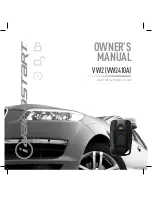
TLR-100/300 SERIES PNEUMATIC REMOTE CONTROLS
Page 10
© 2009 CLEMCO INDUSTRIES CORP.
•
www.clemcoindustries.com
•
Manual No. 22428
5.4.5
To clean the bottom section of the trap, loosen
the bottom thumb screw and swing the lock bar off the
bottom cap, and then remove the cap.
5.4.6
Empty all abrasive from the bottom and top
sections.
5.4.7
Install the screen in the top section. The small
end of the screen must face up.
5.4.8
Reassemble the top and bottom caps. Make
sure the screen gasket is in place in the top cap, and the
O-rings are in place on both caps before assembly.
5.5 Control
handle
5.5.1
A separate manual is provided for the control
handle. Follow instructions in the manual.
5.6
Metering Valve (for ACS systems only)
5.6.1
A separate manual is provided for the metering
valve. Follow instructions in the manual.
6.0 TROUBLESHOOTING
NOTE: This section applies to the remote control
system only. See the appropriate manual for
troubleshooting the blast machine, control handle,
and accessories.
WARNING
To avoid serious injury or death, observe the
following when troubleshooting the remote
controls:
•
Turn off the air, and lockout and tagout the
air supply.
•
When checking the controls requires air,
always enlist the aid of another person to
operate the control handle while holding the
nozzle securely and pointing it in a safe
direction.
•
Never strap down the remote control handle
lever in the operating position.
6.1
Blasting does not start when the control
handle is depressed
6.1.1
Make sure that the air supply is on and all
supply valves are open.
6.1.2
Make sure the safety petcock is closed.
6.1.3
Check for air leaks in control hose, fittings, and
control handle. (RLX Control Handle is covered in
Owners Manual No. 10574)
6.1.4
Check for air escaping from the opening under
the control handle. If no air is escaping, the orifice on the
inlet valve (Figure 6, item 4, or Figure 7, item 4) or the
line from the orifice to the control handle is blocked and
must be cleared.
6.1.5
Open the safety petcock and depress the control
handle. Air should come from the petcock. If it doesn't,
check the following:
•
The opening on the control handle is not being
sealed off.
•
The control handle leaks.
•
The line from the control handle to the upper fitting
on the inlet valve is blocked.
•
If a diaphragm outlet valve is used, check the
diaphragm for a rupture.
If air does rush out, then the inlet valve is not
functioning. Turn off the air supply and service it per
Section 5.1, disassemble the valve, clean and lubricate
it, and replace all worn or damaged parts.
6.1.6
Close the safety petcock, and press the control
handle lever. Check that no air escapes through the vent
hole on the cylinder body of the inlet valve body. Air
escaping from this vent indicates a worn piston in the
inlet valve. See Section 5.1.
6.1.7
With the compressor off and the blast machine
depressurized, check the nozzle for blockage.
6.2
Outlet valve won't exhaust or exhausts too
slowly.
6.2.1
Clean or replace abrasive trap screen. Clean
screen twice daily.
6.2.2
Check to make sure that the lower fitting on inlet
valve (Figure 6, item 4 or Figure 7, item 4) has not been
switched for a fitting with a full flow orifice. The orifice on
the 1/8" NPT end of the fitting must be 1/16" diameter.
6.2.3
Make sure the inlet valve closes. If it does not
seal-off incoming air, the valve requires service.
6.2.4
Disassemble the piston outlet valve, clean and
lubricate it. Replace all worn or broken parts.
6.2.5
Clean or replace the muffler element or muffler.
The procedure to service the muffler is covered in
Muffler Service Instruction No. 22322.





































